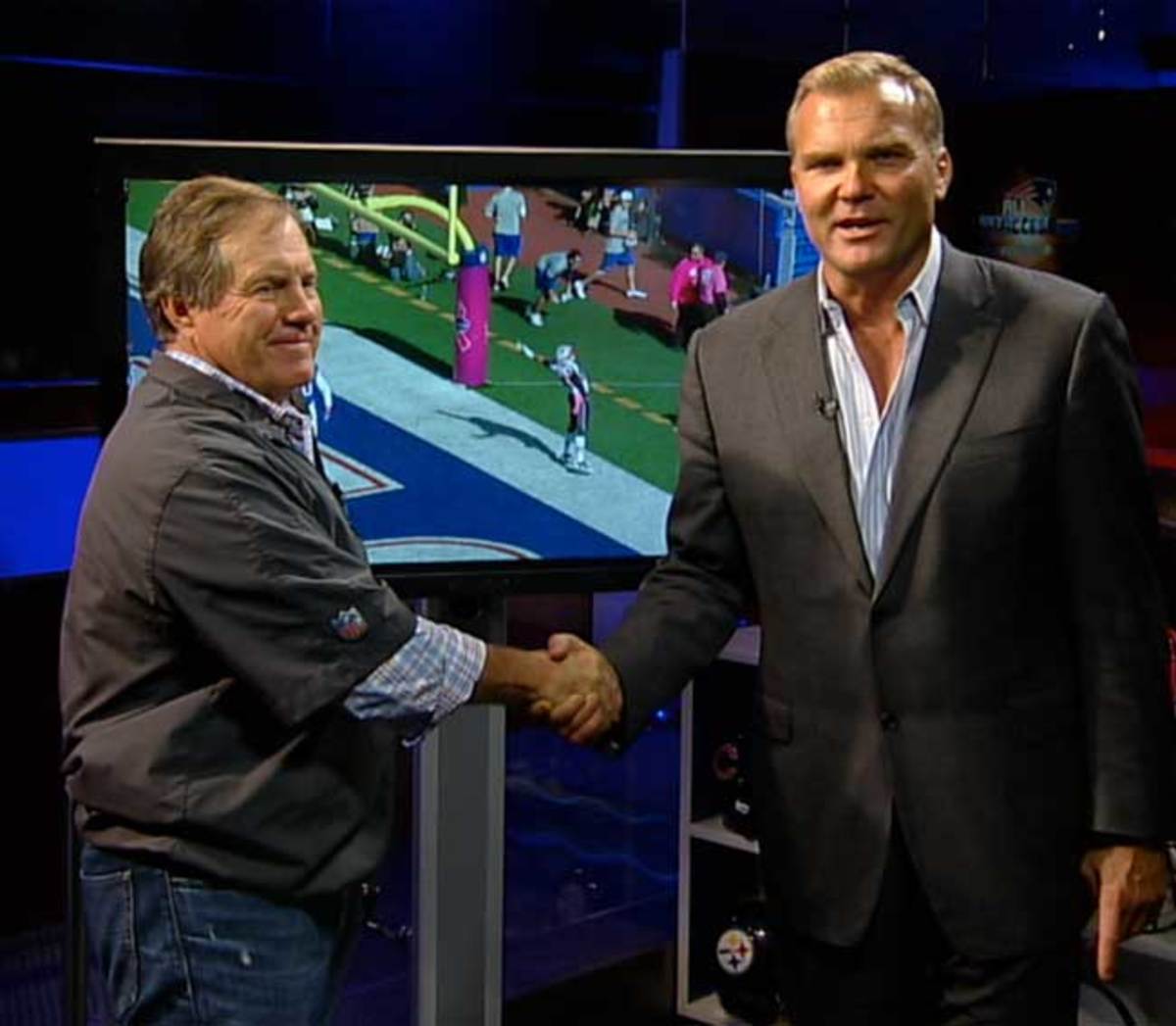The Mad Scientist Doesn’t Wear Makeup

Who is this friendly man on the video screen wearing blue jeans and a striped dress shirt? His demeanor is amiable, he’s expansive with the host, and he’s getting very excited as he describes Tom Brady’s screen pass to running back James White against the Titans on Dec. 20—a play this analyst says is arguably New England’s most well-executed of the season.
As the film shows White zipping past defenders for a touchdown, our man is really getting into it now, explaining how tackle Sebastian Vollmer pinned an opposing lineman at the line of scrimmage, and how center David Andrews and fellow offensive linemen Josh Kline and Shaq Mason held their blocks 10 yards down the field. He then looks further down field and highlights terrific blocks by wide receivers Danny Amendola and Brandon LaFell near the end zone.
“To get those blocks in the open field, to get it all timed out as well as it did on this play, and James White doing a great job of running and setting up the blocks, it was probably one of the best executed plays of the year,” says Bill Belichick.
Wait, this is Bill Belichick, the famous curmudgeonly Bill “We’re on to Cincinnati” Belichick, who makes Gregg Popovich seem like Will Rogers by comparison? Indeed it is. This is Belichick in his natural film-wonk habitat, and it’s something you can watch weekly as part of Patriots All Access, a one-hour show produced by Kraft Sports Productions that airs weekly on WBZ-TV in Boston. Many of the segments are repurposed on Patriots.com, including “The Belestrator” and “Belichick Breakdowns.” Each week Belichick tapes these segments with the purpose of taking Patriots fans into his mind. The Belestrator highlights what to look for in an upcoming opponent, while the Belichick Breakdown examines top plays after a win.
“When he has that clicker in his hand, he’s in his element, and usually right on point.”
“The hardcore crowd loves the segments,” says ESPN’s Mike Reiss, who has covered the team for nearly 20 years, including for The Boston Globe. “I generally post a blog entry on his Belichick Breakdown segment each week because it is terrific insight into the team. and there is usually the same response at least once each week: ‘Do other coaches do the same type of thing, because this is great?’ I make it a weekly appointment because it is insight on what Belichick views as the most significant challenges the team is facing that week. Sometimes it’s obvious (e.g. 11 plays of J.J. Watt leading into the Texans game), but other times not so much (e.g. Eagles special teams). So that Eagles game from Dec. 6 is a good example. What is the first play Belichick shows on the Belestrator? A punt return, noting that the Eagles were a top special-teams unit in 2014, and they are formidable again in 2015. As it turned out, special-teams miscues defending the Eagles’ punt return and punt rush units were critical in a loss. So the main thing I discern from watching the segments, as it relates to Belichick and his film work, is that when he has that clicker in his hand and he’s watching/discussing tape, he’s in his element, and usually right on point.”
Belichick films the segments every Wednesday morning at Gillette Stadium. The studio is located on the field level, about 100 yards from the football offices. Matt Smith, the executive producer of Patriots All Access, says there is no pre-show meeting for the segments, no sheet listing talking points, and no makeup for Belichick. The Patriots coach sends Smith (and the football video staff) an email on Wednesday mornings to let everyone know what plays he has selected to analyze for the show.

The football video group then loads the footage on Belichick’s laptop and brings it to the studio, where it will be plugged into a telestrator so Smith’s crew can become familiar with the plays. For the Belestrator and Breakdown segments, Belichick uses the actual clicker he uses in team meetings because he’s comfortable with that device. The segments’ host, Scott Zolak, a former Patriots quarterback (from the pre-Belichick era) who serves as the color analyst for the team’s radio game coverage, may briefly discuss a couple of the plays with Belichick before the taping begins, but Smith says the segments are mostly organic.
“There is no real rehearsal, and I think one of the most important things we can do to facilitate Coach Belichick is to be ready prior to his arrival,” says Smith, who in 2004 left his local Boston TV producing job to join Kraft Sports Productions. He is now the executive producer of the Patriots’ in-house television department. “We are generally rolling tape less than two minutes from when he walks in door,” Smith says.
Patriots All Access is a PR-heavy magazine-style show that debuted in 1998, two years before Belichick left the Jets to join New England. Belichick did his chalk-talk segments on a whiteboard until Smith joined the show in 2004, when the coach began using a telestator. Smith says it was a viewer who wrote in to the show and suggested the name “The Belestator” for the X’s and O’s segment. In 2009 team president Jonathan Kraft suggested they expand the segment beyond the upcoming opponent and include successful plays from the week before. That component (“Belichick Breakdowns”) primarily runs online at Patriots.com and is filmed only after wins. Smith says management does not sign off on either segment before it airs. (The Patriots PR staff declined an interview request for Belichick but made Smith available for this story.)
No matter your feelings on the Patriots and Belichick, the segments are interesting viewing because they give insight into one of the NFL’s most successful coaches. As Reiss noted, before playing the Eagles on Dec. 6—a game New England lost, 35-28, because of special-teams errors—Belichick was highly focused on Philadelphia’s special teams during his Belestrator segment, as if telegraphing what might happen for the Patriots in a worst-case scenario. The first play he diagrammed was an 89-yard punt return by Eagles running back Darren Sproles against the Jets in September.
When it comes time to film the segments, there are six people on set: Belichick, Zolak, Smith, and three camera people. In the control room, director Dave Mondillo remains in constant contact with Smith throughout the segments, which take about 20 minutes each week. Smith describes him as “cordial, professional, focused and at ease” during the segments, and says that whenever there are occasional mispronunciations or mistakes by either the host or the coach, they simply start again.
“I don’t want to overproduce it,” Smith said. “This is Bill Belichick breaking down tape. In that instance as a producer, you have to get out of the way. This is what he does best, as one of the best coaches in the history of the game. You overproduce it with dozen of cameras and it would be a real disservice. When I come to him with any idea, he will say, ‘Do you think it’s better for the show?’ When I say it is, he is more than willing to go along with it. I can’t speak for him, but I think there is an understanding that when he comes down here he knows what is expected of him and if there is something else we need to do, he’ll say no problem. He takes direction very easily.”
Zolak says he tries to pose his questions in football-centric ways that will interest the coach.
“That’s his wheelhouse,” says Zolak, who has hosted the Belichick segments for the past five years. “I don’t have to dumb questions down. I think these segments show he wants to relate to fans more. I know there is an opinion that the coaching staff here keeps things close to the vest and is close-minded—and some of that is true—but Bill will often surprise you on the show with his manner. I know he gets a kick out of showing something that worked in practice that also worked in the game, and the fans love that, too.”
Zolak believes Belichick would be a terrific television analyst should he ever want to go that route.
“I think he’d be damn good,” says Zolak. “It’s the mad scientist about him. He looks at things differently.”
